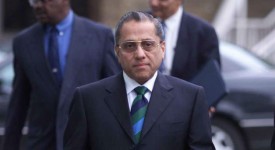Team India director opens up about the role he plays inside the Indian dressing room
There is an unmistakable ‘No Nonsense’ air about him. There is conviction in his thoughts and he puts them across unabashedly. With a 10-year long international career to his name and a quarter of a century worth of experience as a cricket expert, his cricketing credentials are second to none. And he has a youthful flamboyance that makes him receptive to the younger generation. He also commands their respect. When he talks, they listen. His positivity is infectious and his talks are straight.
In more ways than one, Ravi Shastri is the ideal man to guide the current young Indian Team. He was appointed the Team Director midway through India’s tour of England last year and it has been eight months into the job for Shastri. In his short tenure so far, the former India captain has overseen one of the toughest phases of the team, with the tour of England and Australia. He has also been part of the team that beat all odds to make the World Cup semi-final.
In a free-wheeling conversation with bcci.tv, Ravi Shastri gives an account of the last eight months and elucidates the exactness of the role he plays within the team.
Every player I have spoken to since you joined the team, has raved about the positivity you bring in the room. That surely comes naturally to you?
It does, but to reflect that on other personalities requires some straight talking. It’s basically about making them believe in their own abilities and that as a unit they are one of the best in the world. When it’s constantly mentioned and when you have results to prove it, it becomes infectious and is transferred from one player to another. In the eight months that I have been with the team, we have won about 75 to 80 per cent of the ODIs. Yes, we had a bad loss against Bangladesh but you learn from that and bounce back. This team has been through some tough terrain, in England and Australia, and they would have learned a hell of a lot from those tours.
The way India competed in Australia won them many admirers. Have you seen a distinct change in the team’s attitude post that tour?
You will see the values of that Australian tour in time. It was massive. People don’t realise the level and intensity these boys played with right through that tour. They fought through the four Test matches and after having spent four and a half months there, they saved their best for the last three weeks. I want to see how many teams who go there for that period of time, against that Australian attack and fight as hard as we did. I am not trying to get over the top here. The genuine observers and people who understand the game, will know where I am coming from.
How difficult was it to maintain that positive attitude within the team during these tours?
That was my biggest challenge, to make them believe that everyday is an opportunity. When you go out on the field to play for your country, there are millions of people watching you on the television. There’s no better arena to enjoy yourself than on the cricket field. You cannot have a ball in the hotel room. The best place to have a ball is out there. Convert that pressure into enjoyment. What better job is there in the world – you go out there, score a hundred, people clap. You take a good catch and people clap. You have a good day, you are interviewed by the media. What else do you want? Why complain?
How would you define your role within the team – is it more about motivating the boys or do you also get involved in tactical and strategising matters?
Very much. That part is instrumental in the team knowing its strengths. It starts with every individual knowing his strength and then it is about identifying those strengths and putting it collectively for a strong unit. You cannot take anything away from experience. I have been involved with the game for over 35 years – as a player and broadcaster. I’ve watched huge amount of cricket, seen a lot of teams evolve over the years or go through that phase of rebuilding. There is plenty that I have seen in the game to be able to offer something to these young boys. I will not call myself a coach at all. I am more of a mentor and as the director of the team I oversee what the coaches do. On this tour we don’t have a tag of a head coach but we have specialist coaches. Anyone of them can take the title of a head coach and I am there to oversee things.
Do players also come to you for counseling and a little pep talk when they are down? A bit of psychology also involved in your role?
Massively. That is really the key to what I do. If they don’t have the trust to walk up to me and speak to me then I might as well not be here. But the fact of the matter is that they all do come and speak freely to me. There is that comfort factor where the boys feel that Ravi is like an elder brother to them and they can go and talk to him about whatever they want. They can open up about anything, be it cricket-related or personal. And they know we will come up with a way of dealing with it.
I was speaking to Ashwin in Adelaide and one thing he said was – when you got into the team, he came to you and said how he likes to talk about the game at the end of every game day, discuss everything that happened on the field on that day. And you said we will do it from now. How do those talks go?
It is brilliant! Because you know immediately where you can improve and what you can do better, or if you have done well, don’t think too much. Keep it simple and do exactly the same thing. Sometimes, you need a wall to throw your thoughts at and something bounces off it. It worked very well. When we landed in Australia Ashwin was not at his best. If he were bowling half as well as he bowled later on the tour, he would have played the first Test match and that would have been very handy for us. But credit to him that he grasped things very quickly and learned quickly what had to be done. He stuck by it and the results are there for everyone to be seen since the World Cup. Game after game he is offering something and bowling well consistently.
With some players who tend to think too much about their games, do you also have to ask them to relax?
I always have a chillax pill in my pocket. I just tell them, ‘Get a bottle of water and take this’. But it is an important point that you make. Sometimes, you get into the habit of over-analysing and you create problems for yourself that don’t exist. That’s when I step in and, in no uncertain terms, tell the guy, ‘Just back off. You’re playing well, just get on and concentrate on what you’re doing right. Forget where your hand is going or how your feet are moving. Just watch the ball and do what feels right. And you don’t have to do anything else’.
You suggested to Virat about making a slight change in his stance in Australia. He said he was skeptical in the beginning but you asked him to trust you. He did and it worked. How tricky is it to convince players to make these technical changes?
It is not tricky. It only gets tricky when you tell someone to do something and you don’t have a solid reason for it. There are so many experts who come and tell a player that he should do this or that. But why should he do it? ‘Just because I think it will be good for you’. If you don’t have an answer to why you are asking him to do something, you may as well shut up. Again, when you suggest something to a player, it is not necessary for him to go out and do it immediately. He can take his time, like Virat did. I told him to make that change in his stance on the basis of what I saw in his batting in England. In England I was doing a live show on the TV and I saw a lot of cricket, highlights and action-replays, and I picked something.
What exactly did you tell him and what was your reason?
I just told him to use the crease better so he can work with lengths and angles and make the bowler bowl differently to him. I told him that as a batsman the crease was his domain. He can stand wherever he wants to. It took a while but he understood it and tried it in the nets. He was bold enough to straight away take a chance in the very first Test, in Adelaide. From there it was no looking back.
How different is Ravi Shastri the commentator from Ravi Shastri the Team India director?
You don’t change as a personality but the job is totally different. For me this is arguably the most responsible job you can get. It has a lot of job satisfaction. There is a time in one’s life where you get a knock on your head. I don’t know who was knocking me but I got that knock that said, ‘Come on! You have been around for so long, this game has given you so much. Surely you can contribute in a bigger manner and give something back to the team’. At times, it can be a thankless job because in our country you either keep winning or face the brickbats thrown your way. And when it comes to that, there is no one more seasoned than I am. I have seen it all, as a player as a broadcaster. There is a layer of skin that is thicker than most others have. A lot of people have tried to penetrate it and I assure you, there is no needle in the market yet to get through it.
During your 10-year long career for India, you were known as a fighter – you batted in all positions and were game for whatever challenge was thrown at you. Do you wish to instill a similar spirit in these boys?
I think it is already there. You have to treat even the toughest of situations as a challenge. If I ask someone to open the batting, instead of thinking, ‘Oh, he’s asked me to open. What if I fail?’ it should come from within him to say, ‘Give me that bat. I am going to do this because it is an opportunity to score big runs’. This was a very big part of my cricket. It was always a challenge for me to get runs against the best teams, and there is no better position to do it than at the top of the order. When it comes to inculcating a similar belief in these boys, I don’t have to say much to them.
How has the dual captaincy system been working for the team since the time Virat took over as Test captain?
What people don’t realise is that there is tremendous mutual respect there between Virat Kohli and MS Dhoni. When MS was at his prime as India’s Test captain, Virat was only a youngster. There were times when Virat’s place wasn’t certain in the side and MS stuck by him. Such things are not forgotten. I can sense and see that respect without anyone having to tell me.
What is the one biggest change you have tried to bring about in the dressing room and how successful have you been?
Honesty and openness. I told the boys, ‘Whatever you want to say, say it in the dressing room, not behind anyone’s back’. A conscious effort was made to bring this honest environment about. I cannot say if I did it or not but I have seen massive improvement. The players have opened up much more from when I joined the team. There is trust there and there are benefits there. I told the guys, ‘Whatever is on your mind, rather than keeping it all bottled up, get it out’. Doing that not only relieves your mind but also develops your personality. When you speak out, it gives you confidence and helps you get over that complex barrier. You start looking at life and how you play the game differently.
There is also mutual trust among the group. They want to play for each other and genuinely enjoy each other’s success. That is the healthiest quality a team can have. If there is a guy who is just happy with his own performance and doesn’t bother much about the others, when he goes through a bad patch, he will be on his own. And that has been pointed out to the team on various occasions.
Source: BCCI.tv




